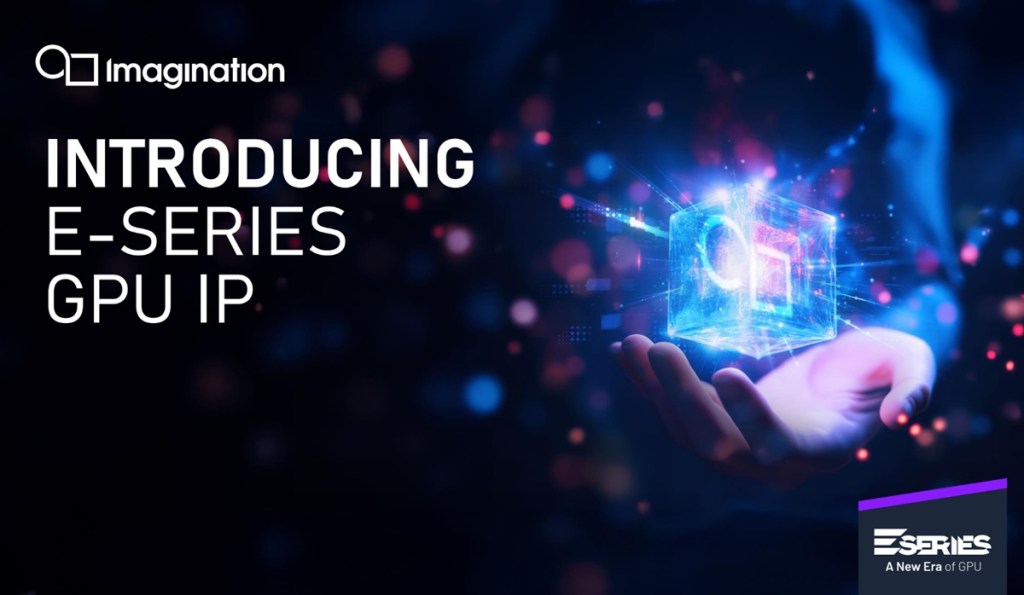Imagination Technologies is unveiling its E-Series graphics processing units (GPUs) for graphics and AI processing at the edge.
Imagination said the products redefine edge AI and graphics system design with the launch, leveraging a highly efficient parallel processing architecture to provide exceptional graphics performance while also scaling from two to 200 TOPS INT8/FP8 for AI workloads.
In a briefing, Kristof Beets, vice president of product management at Imagination, told me that the GPUs have a clever blending of AI processing components within the chip so that it most efficiently handles the processing tasks at hand. That helps distinguish it from other GPUs on the market and enables Imagination to target specialty markets like automotive.

He said the GPU family offers a versatile and programmable solution for future edge applications including graphics, desktop applications, natural language processing on smartphones, industrial computer vision, and vehicle autonomy.
Two new technologies underpin E-Series’ potential to transform edge system design:
Neural Cores: Scaling up to 200 TOPS (INT8/FP8), these cores deliver significant acceleration for AI and compute workloads.
Burst Processors: A highly innovative solution delivering a 35% improvement in average power efficiency for edge applications.
“On-device AI is evolving rapidly, but edge AI system designers still face challenges in balancing performance and efficiency with flexibility,” said Phil Solis, research director at IDC, in a statement. “Imagination has leveraged its long-held experience developing power-efficient GPUs and evolved them to flexibly support both graphics and AI workloads for on-device AI. The E-Series combines the programmability of GPUs with a boost in AI performance to create a compelling solution for on-device AI system designers.”
High performance acceleration for low power AI

E-Series continues to offer the advanced graphics capabilities of previous generations of Imagination GPUs, including support for ray tracing. To this, it adds deeply integrated acceleration for power-efficient, low precision AI operations into every GPU core. This creates the compute-dense E-Series Neural Cores that scale up to 200 TOPS INT8 and unleash up to 400% the AI performance of the previous D-Series.
The Neural Cores support a wide range of popular AI number formats, enabling developers to design networks that meet a broad spectrum of performance, accuracy and power demands. One of their many performance efficiency measures is an AI-friendly memory architecture that prioritizes local memory for compute, greatly reducing the power and performance costs of going to external memory.
Programmable AI for future-proof system design

GPUs are programmable processors that future-proof devices against the continuous evolution of AI, compute and graphics workloads. The E-Series Neural Cores align with the broader GPU and heterogeneous computing software ecosystem by deeply integrating AI acceleration across the GPU.
Their capabilities can be unlocked by popular APIs, like OpenCL, and developers can easily move their workloads onto the Neural Cores using open standards and tools like oneAPI, Apache TVM or LiteRT. Imagination’s compute libraries and highly optimised graph compiler maximise GPU efficiency.
“The integration of Edge AI hardware and software is crucial for unlocking the potential of on-device intelligence,” said Parv Sharma, senior analyst at Counterpoint Research. “E-Series empowers developers to deploy on-device AI algorithms across multiple applications and end devices.”
Efficient processing for sustained edge AI and graphics performance

Imagination’s PowerVR GPU architecture is renowned for its energy efficiency and has been deployed in power-constrained devices for nearly twenty years. The ESeries’ new Burst Processors technology enhances power efficiency by a further 35% for AI workloads, games and user interfaces. This improvement is achieved by reducing pipeline depth and minimising data movement within the GPU.
The GPU that does more
Modern devices are increasingly complex and processors are required to support multiple graphics and AI workloads simultaneously. Ensuring quality of service (QoS) and clear prioritisation across these workloads is critical to user experience.
The E-Series enhances the multitasking capabilities of previous generations by doubling the number of hardware-backed, zero-overhead virtual machines supported by Imagination GPUs to sixteen, with sophisticated QoS support. Multicore variants of E-Series GPUs can leverage additional cores for either extra performance or enhanced flexibility. These GPUs are capable of handling multiple graphics workloads, multiple AI workloads, or a combination of both simultaneously.
“The E-Series will place the GPU at the centre of both graphics and edge AI systems,” said Tim Mamtora, chief of innovation and engineering at Imagination, in a statement. “For system designers needing to run both graphics and compute workloads, an E-Series GPU is a versatile solution that eliminates the need for additional vector-based or fixed function AI solutions, giving future-proof flexibility while saving on total system design costs.”
The first E-Series GPU IP is available in Autumn 2025 and has already been licensed. Automotive, consumer, desktop and mobile variations are in development.

